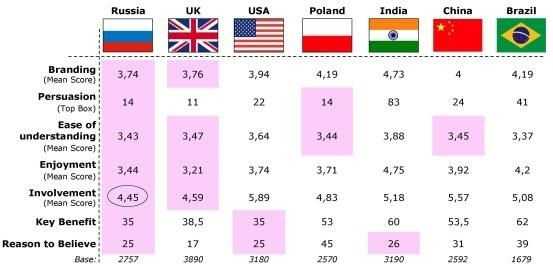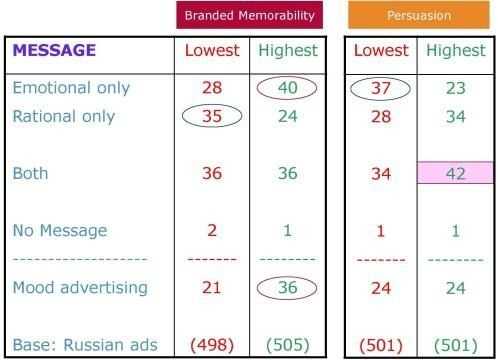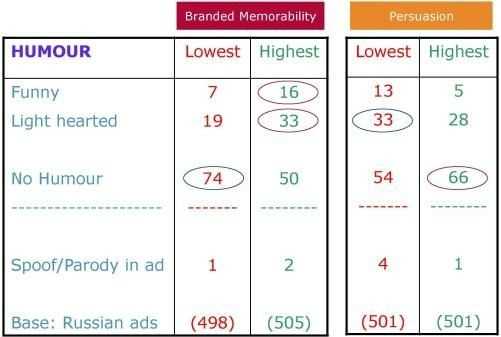Blog about successful marketing strategies in russia
How to adapt a foreign brand marketing strategy for Russia?


B2B MARKETING
Share this Post
Good day!
How to adapt a foreign brand marketing strategy for the Russian market?
The peculiarities of Eastern and Western Advertising.
The success of every advertisement campaign not only depends on the placement channel, but also on the customization. In this regard, if we are talking about customers from different countries, there are some readily visible traditional and cultural differences.
If we look at the chart below, we can see how similar or different TV advertisement rates are in various countries, which has been evaluated according to the practices of LinkTM company Millward Brown (in Russia - A / R / M / I-Marketing). In particular, Russian and Chinese advertising have almost the same rating of "Easy to understand" index, and the British and Russian have comparable values of 5 out of 7 indexes.

Note:
This study evaluated indexes such as:
1. Branding advertising – The connection with the advertised brand – on a 5-point scale.
2. The persuasiveness of advertising - Calculates the percentage of those who are persuaded by the advertisement to (continue to) buy the advertised product or service.
3. Ease of understanding of the plot – on a 4-point scale.
4. The pleasure of watching – on a 5-point scale.
5. Involvement in view - The difference between active and passive involvement – on a 10 point scale.
6. Carrying of the main advertising message – How direct the advertising message is (in percent).
7. Reasons to believe advertising - Calculates the percentage of those who need proof before they will believe an advertisement.
The last line shows the number of commercials that participated in this study, carried out over several years.
Source: A/R/M/I-Marketing
How is the difference in TV advertising perception expressed in practice? Let's look at variations in commercials for fast food chain McDonald's in different countries.
For analysis we took the following Russian McDonalds commercial:
Explanation: this commercial uses the character of Tsar Ivan Vasilievitch from a famous comedy of soviet times.
Commercials in Russia and USA: images
(USA) https://www.youtube.com/watch?v=jtdaNbcD1s8
Both in U.S. and Russian versions the commercial is built around an object which is meaningful to the audience. In the U.S. it is football, of course; but in Russia it is a character from a popular comedy that everyone is familiar with.
Why was this image involved?
First, a connection with the product. A specific burger is being advertised, with special ingredients which are traditional Russian products: rye bread and minced beef. Second, we observe a strong association with customary Russian cuisine which is connected with the Tsar era.
What is the difference between the American and Russian commercials?
We should also note the presentation format. In the Russian version we have a concrete character, whom the viewer associates himself with, while the American commercial is quite abstract.
Russian and Japanese commercials: history
Let`s compare a Russian commercial with a Japanese one that also has a character involved.
What`s the difference?
The Japanese video character does not refer us to any associations, advertising directly one of McDonald’s products and fixing the image of a clown in our mind. We are not assessing how it influences the effectiveness of the Japanese advertising, but let`s take a look at the Russian commercial.
The presence of the film character, familiar and beloved by lots of people in the Russian commercial, involves a wide audience of all ages, because tsar Ivan Vasilievitch is known by different generations.
Besides, it is already a short story, a short movie being watched with pleasure by different kinds of people, not just a direct advertisement that can escape observation.
According to the results of the study we took a look at earlier, although in the last few years the level of "involvement" parameter in TV advertising slightly decreased, the significance of "fun" parameter is quite the opposite, increasing steadily.

Source: A/R/M/I-Marketing
Russian and Chinese commercials: emotions.
Chinese TV commercials also tell us a story. Let`s take a look.
The first thing we notice is the focus on different target audiences. In Russia McDonald's has gained popularity among students as an inexpensive eatery which can also be used as a place for discussing projects, as long as the chain has free Wi-Fi. In China, not many McDonald's stores have free Wi-Fi, and in addition, the prices in this fast food chain are higher than in other fast-food establishments. This is the reason why most of the McDonald's audience in China are foreigners who cannot get used to Asian cuisine.
But if we take a look at these commercials again, we can notice a common feature - the emotional component of the advertising message. In the case of the Russian commercial, we see the emotional connection of the Beef a la Rus burger with Russia in general, with its history and the values of the Russian people. It is emotionality that draws you into watching this video, although the rationality of the commercial is the information about the ingredients of meals and the events going on, it convinces potential customers to visit McDonald’s.
We observe from the table below that the emotional part can carry the brand message to the audience effectively.

Note: parameters such as brand memorability and persuasiveness of advertising, according to the ratio of the rational and emotional messages were estimated. The data are presented as percentages based on a study of Russian commercials. Source: A/R/M/I-Marketing
Russia and South Korea: humor
Let`s take a look at one more McDonalds commercial, this time a South Korea one.

Undoubtedly, both Russian and Korean commercials have something in common - the presence of history and humor. Right after the Tsar appears on camera we can feel a hint of intrigue and some anecdotal plot developments. Surely, funny commercials in Russia are remembered much better than commercials without any humor.
We can see this in the table below
Note: parameters such as brand memorability and persuasiveness of advertising, depending on the presence of humorous component, were evaluated. This data is presented in percentages based on a study of Russian commercials. Source: A/R/M/I-Marketing
Just as we expected, Russian TV commercials have common characteristics with the other countries’ commercials. At the same time, it has its own specific features influenced by the globalization of markets as well (we can see it clearly in McDonald’s example).
How to create effective commercials for the Russian market?
Entering the Russian market is clearly connected with the study of national identity, language and other cultural traditions. If you suppose you need to use TV advertising you will need this information to deliver the advertising message.
Creating an advertising campaign needs 4 steps:
- Study the target audience
- Choose the advertisement placement channel
- Tell a fascinating story
- Include emotions and rationality
However, despite the simplicity of these steps, you may find out that doing this work by yourself and hitting the target is difficult. Consult with professionals that can help you solve the problem of creating an effective television campaign.
Best regards,
Vadim Tylik
Join 2,000+
of your Peers!
You will be the first to know about Russian marketing insights, news and updates from our agency. Stay tuned!
Get our latest articles delivered to your email inbox and get our exclusive White Paper
"How to sell to Russian large companies?"
for FREE!
How to Sell to Russian Large Companies?
More about Russian b2b marketing

Ready to partner with the specialists in Russian marketing and advertising?
About the Author
Digital Strategist. Head of one of the project groups at RMAA. Maria started her journey in digital marketing in 2009.
Join 2,000+ of your Peers!
Get our latest articles delivered to your email inbox and get our exclusive White Paper "How to sell to Russian large companies?" for FREE!
You will be the first to know about Russian marketing insights,
news and updates from our agency.
Stay tuned!















